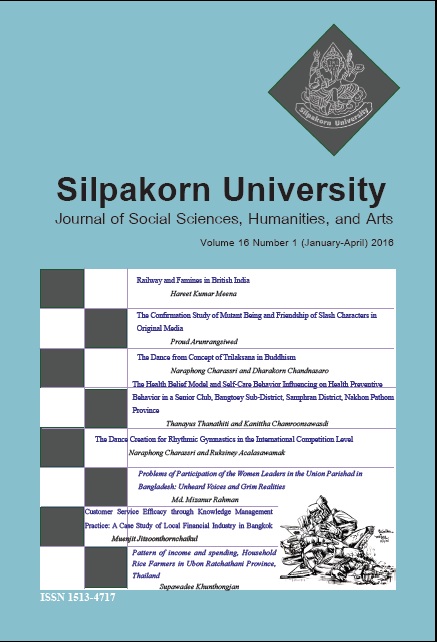The Confirmation Study of Mutant Being and Friendship of Slash Characters in Original Media
Main Article Content
Abstract
This quantitative content analysis was conducted to confirm the findings of past qualitative studies in the area of Slash or Yaoi fan creations. Slash or Yaoi fan creations include homosexual relationship between two male characters borrowed from original media, such as movies and comics. The findings of past research were that (1) Slash characters were nonhuman being, and (2) homosexual relationship in Slash fan creations was developed from friendship in original media. The results support that most Slash characters were nonhuman being. On the other hand, homosexual relationship in some type of Slash pairing was developed from enmity, not from friendship. This finding suggests that the future research should examine the relationship between the villain-related Slash pairings and fan artists’ personal characteristic. Moreover, the violence in villain-related Slash fan art should be identified.
Downloads
Article Details
All rights reserved. Apart from citations for the purposes of research, private study, or criticism and review,no part of this publication may be reproduced, stored or transmitted in any other form without prior written permission by the publisher.
References
Bolt, W. L. (2004) The Hidden Authors: A Study and Survey of Fan Fiction Writers. University of Tennessee Honors Thesis Projects. [Online URL: https://trace.tennessee.edu/utk_chanhonoproj/715] accessed on March 21, 2015.
Brennan, J. (2013) Slash Manips: Remixing Popular Media with Gay Pornography. M/C Journal 16(4). [Online URL: https://www.journal.media-culture.org.au/index.php/mcjournal/article/viewArticle/677] accessed on April 1st, 2015.
Cumberland, S. (2003) Private Uses of Cyberspace: Women, Desire, and Fan Culture. In Rethinking Media Change:The Aesthetics of Transition,edited by D. Thorburn and H. Jenkins, pp. 261-279. Cambridge, MA: MIT Press.
Dennis, J. P. (2010) Drawing Desire: Male Youth and Homoerotic Fan Art. Journal of LGBT Youth 7(1): 6-28.
Ishikawa, Y. (2008) Yaoi: Fan Art in Japan. Comparative Studies on Urban Cultures,11-13. [Online URL: https://educa.lit.osaka-cu.ac.jp/~ggp/nakami/2008/2008ISIC_ResearchPresentations17.pdf] accessed on April 1st, 2015.
Jenkins, H. (1992) Scribbling in the Margins: Fan Readers/Fan Writers. In Textual Poachers. Television Fans and Participatory Culture: Television Fans & Participatory Culture. Routledge, NY.
Kalinowski, P. (2014) The Fairest of Them All: The Creative Interests of Female Fan Fiction Writers and the Fair Use Doctrine. William & Mary journal of women and the law 20(3): 655-709.
Kirby-Diaz, M. (2009) So, What’s the Story? Story-Oriented and Series-Oriented Fans: A Complex of Behaviors. In Buffy and Angel Conquer the Internet: Essays on Online Fandom, edited by Mary Kirby-Diaz, pp. 62-86. Jefferson, NC: McFarland & Company.
Kustritz, A. (2003) Slashing the Romance Narrative. The Journal of American Culture 26(3): 371-384.
Lam, F. Y. (2010) Comic Market: How the World’s Biggest Amateur Comic Fair Shaped Japanese Dōjinshi Culture. Mechademia 5(1): 232-248.
Lamerichs, N. (2013) The Cultural Dynamic of Doujinshi and Cosplay: Local Anime Fandom in Japan, USA and Europe. Participations 10(1): 154-176.
Leavenworth, M. L. (2009) Lover Revamped: Sexualities and Romance in the Black Dagger Brotherhood and Slash Fan Fiction. Extrapola-tion 50(3): 442-462.
Lopez, L. K. (2012) Fan Activists and the Politics of Race in The Last Airbender. International Journal of Cultural Studies 15(5): 431-445.
Olin-Scheller, C. and Wikström, P. (2011) Literacies on the Web: Co-Production of Literary. In Interactive Media Use and Youth: Learning, Knowledge Exchange and Behavior: Learning,Knowledge Exchange and Behavior, edited by Elza Dunkels, Gun-Marie Franberg, and Camilla Hallgren, pp. 65-79. Hershey, PA: IGI Global Publishing.
Prigent, C. (2001) A Regard for Painting. In As Painting: Devision and Displacement. Cambridge, MA: MIT Press.
Salah, et al. (2012) DeviantArt in Spotlight: A Network of Artists.Leonardo 45(5): 486-487.
Salmon, C. and Symons, D. (2004) Slash Fiction and Human Mating Psychology. Journal of Sex Research 41(1): 94-100.
Scodari, C. (2003) Resistance Re-Examined: Gender, Fan Practices, and Science Fiction Television. Popular Communication 1(2): 111-130.
Tan, K. B. (2008) Unauthorized Romances: Female Fans and Weiss Kreuz Internet Yaoi Fanfiction. Thesis, Department of Japanese Studies, Faculty of Arts and Social Sciences, National University of Singapore, Singapore.
Tosenberger, C. (2008) Homosexuality at the Online Hogwarts: Harry Potter Slash Fanfiction.
Children’s Literature 36(1): 185-207.
Vasilyeva, A. I. (2011, May 17-20) Literary Fanfiction as a Kind of Public Journalism. Paper presented at научной конференции студентов иаспирантов Белорусского государственного университета: 78-80. ISBN: 978-985-476-913-4.
Woledge, E. (2005) From Slash to the Mainstream: Female Writers and Gender Blending Men. Extrapolation 46(1): 50-65.
Woledge, E. (2006) Intimatopia: Genre Intersections between Slash and the Mainstream. In Fan Fiction and Fan Communities in the Age of the Internet, edited by Karen Hellekson and Kristina Busse, pp. 97-114. Jefferson, NC: McFarland.


